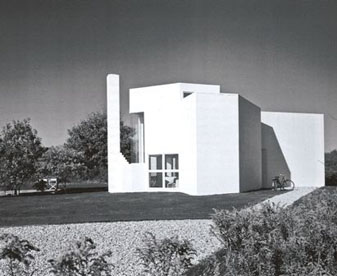James Merrell Architects
66 Main Street
Sag Harbor
___________________________________________________________________

A Laboratory for Architectural Design
“Modernity in no way denies history.”
— Jorg H. Gleiter, Professor of Aesthetics at the Faculty of Arts, Free University of Bozen-Bolzano
In the Hamptons, we are surrounded by almost four centuries of architectural history. We are proud of this history, and for good reason, as we live among exceptional examples of architecture from every period. In fact, we architects refer to this history and these precedents almost daily, as we design new houses and evaluate old ones. And we invoke this history when we get upset by the new developments that are constantly confronting us. But do we understand, or have a functional definition for, this term that we invoke so freely? I’m not so sure.
I was an American Studies major in college, which is a kind of history degree, but I would not claim to have a good definition for history. If pressed I’d probably say that history is everything in the past, separate from today, but available to us through documents and artifacts. And while this definition falls well short of a theory, I think it approximates a definition that most people would accept.
 Today we see this definition of history at work in newspaper articles and editorials. And we hear it elaborated in public conversations at our historical and architectural review board hearings.
Today we see this definition of history at work in newspaper articles and editorials. And we hear it elaborated in public conversations at our historical and architectural review board hearings.
In all of these venues history is typically something that needs to be preserved, not made. Priority is given to the historical artifact, the “historic fabric.” When there is no artifact present, concern quickly focuses on “compatibility” and consistency of style. But in neither case is any accommodation made for the future, for the making of more history, or for the artist. On the contrary, the standard view of history places artsts and preservationists in opposition.
As an architect I have, of course, wrestled with this opposition. After all, becoming an architect presumes a love of great buildings no matter their century. And I have also wrestled with the challenge of “renovating” important structures. But I never had a theory of history that could help me, until now. Recently, I came across an online lecture that changed everything. It was by a German aestheticist, Jorg Gleiter, speaking at a Belgrade University symposium to honor one of my teachers, the architect Peter Eisenman.
Gleiter proposes that each generation has to make its own claims on the past. “As a factual entity the past precedes the present time, yet…only from the present day perspective, decades or even centuries later, do past facts turn into historical facts.”
 In his view history is not what takes place in the past, contemporaneous with its artifacts; rather history is what we make of those facts today, as we actively scrutinize them through the lens of our own time! By giving us agency in the present, Gleiter eliminates the distance between art and history, architect and preservationist. Perhaps counter-intuitively, he suggests that it is not the preservation of past facts that preserves history, but our reengagement, our “renovation” of them that revitalizes the past for today. History is a creative process.
In his view history is not what takes place in the past, contemporaneous with its artifacts; rather history is what we make of those facts today, as we actively scrutinize them through the lens of our own time! By giving us agency in the present, Gleiter eliminates the distance between art and history, architect and preservationist. Perhaps counter-intuitively, he suggests that it is not the preservation of past facts that preserves history, but our reengagement, our “renovation” of them that revitalizes the past for today. History is a creative process.
Because we live in the Hamptons, in a veritable laboratory for architectural experimentation, we can see examples of this history playing out in our landscape. And I have selected the images for this piece to illustrate this view. The houses pictured here are all groundbreaking designs from the 1960s and 1970s. Most are world-famous, and I have always admired them for their compositional and architectonic merits — qualities that are largely intrinsic to each design, so not “historical.” But after hearing Gleiter, I believe they have historical merits as well.

Today we call these houses modern, even though they were constructed at least 40 years after the heyday of Modernism. So, while they cannot be truly Modernist, they are modern, because they grapple with those Modernist precedents in the material and mindset of their own day. In this history, artistic agency is not only permitted, it’s required. Without it, history would be limited to the mimicking of past architectural motifs and styles, which inevitably dilutes them. But in Gleiter’s view the architect and historian have the same job, to “preserve” history by giving contemporary currency to the events and perspectives of the past.
As he says, “truly innovative design … make(s) visible in the past something that we can only see from the perspective of today.”

Visit: www.jamesmerrellarchitects.com
— April 2015 Journal Entry
———————————————————————-
To view Jorg H. Gleiter’s talk: https://www.youtube.com/watch?v=6ppr-0LSij
Images in order:
Saltzman House by Richard Meier, photo by Ezra Stoller
Pearlroth House design and photo by Andrew Geller
Motherwell house by Pierre Chareau
Gwathmey House by Charles Gwathey, drawing by Andrea Vince
Project in design by James Merrell Architects
___________________________________________________________________________

